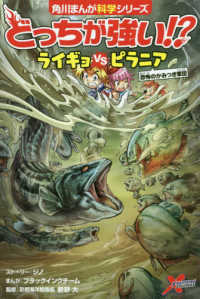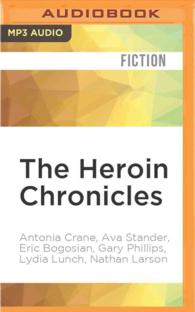- ホーム
- > 洋書
- > 英文書
- > Literary Criticism
Full Description
Edited with an introduction by Hilary Emmett & Thomas Ruys Smith in collaboration with students from the Department of American Studies at UEA.
Author and activist Lydia Maria Child was a foundational figure in the development of American literature in the early nineteenth century. After her debut novel Hobomok (1824) challenged readers with its representation of interracial marriage, she continued to blaze literary trails for the rest of her life, developing a loyal readership as she confronted the most pressing issues in American life. She wrote novels, poems and short stories, composed housekeeping and parenting manuals, edited abolitionist newspapers and narratives—most notably Harriet Jacobs' Incidents in the Life of a Slave Girl (1861). Less well-known is that she almost single-handedly invented a new American literature for children. For decades, and particularly during her time at the helm of groundbreaking children's magazine The Juvenile Miscellany (1826-1834), Child was a constant companion for young readers across the world.
For the first time, this anthology brings together a career-spanning collection of Child's writing for children which demonstrates the extraordinary richness and range of her vital work in this field. As she shaped the idea of what children's literature could be and do, Child trusted her young readers to understand difficult questions of social and racial justice, explorations of natural and national history, sentimental domestic sketches, and much more besides. Contemporary readers can now rediscover the delight that the arrival of a new issue of The Juvenile Miscellany brought to the world while grappling critically with the ongoing resonance of these questions in the twenty-first century.
Contents
Contents:
Introduction
Hilary Emmett, Thomas Ruys Smith, students from the Department of American Studies at the University of East Anglia.
Preface:
"Address to the Young", Juvenile Miscellany (September 1826)
Indigenous Peoples:
"Indians Outwitted" from Evenings in New England (1824)
"Indian Tribes" from Evenings in New England (1824)
"Adventure in the Woods" from The Juvenile Miscellany (September 1826)
"Adventures of a Bell" from The Juvenile Miscellany (March 1827)
"Pol Sosef, The Indian Artist" from The Juvenile Miscellany (January and February 1831)
"Mary Howard" from The Girls' Own Book (1833)
Race, Slavery and Abolition
"The Little Master and His Little Slave" from Evenings in New England (1824)
"The St. Domingo Orphans" from The Juvenile Miscellany (September and October 1830)
"Jumbo and Zairee" from The Juvenile Miscellany (January and February 1831)
"Life in the Desert" from The Juvenile Miscellany (May and June 1831)
"The Little White Lamb and the Little Black Lamb" from The Juvenile Miscellany (March and April 1833)
"William Peterson, The Brave and Good Boy" from The Juvenile Miscellany (March and April 1834)
"Mary French and Susan Easton" from The Juvenile Miscellany (May and June 1834)
History and Revolution
"History" from Evenings in New England (1824)
"Fabled Correspondence between Forefathers' Rock and the Tree of Knowledge of Good and Evil" from Evenings in New England (1824)
"The Young Hero" from Evenings in New England (1824)
"The Little Rebels" from The Juvenile Miscellany (September 1826)
"Benjamin Franklin" from The Juvenile Miscellany (March 1827)
"Conversation Between a Little Boy of Olden Times, and a Boston Boy of 1827" from The Juvenile Miscellany (September 1827)
"The Little Greek Girl" from The Juvenile Miscellany (September 1827)
"American History" from The Juvenile Miscellany (September 1828, January 1829, March 1829, May 1829, July 1829, September 1829)
The Natural World
"Trees" from Evenings in New England (1824)
"The Adventures of a Dandelion" from Evenings in New England (1824)
"Coral Reefs" and "Wonders of the Deep" from The Juvenile Miscellany (November 1826, January 1827)
"Birds" from The Juvenile Miscellany (May 1827)
"Insects" from The Juvenile Miscellany (July 1827)
"The Squirrel" from Flowers for Children (1854 [1844])
"Aunt Maria's Swallows: A True Story" from Flowers for Children (1854 [1847])
"Secrets of Nature" from A New Flower for Children (1856)
Work, Wealth and Poverty
"Conversation on Wealth" from Evenings in New England (1824)
"The Young Bookseller" from Evenings in New England (1824)
"Louisa Preston" from The Juvenile Miscellany (March 1828)
"The Fairy: A Fable" from The Juvenile Miscellany (September 1829)
"The Industrious Family" from The Juvenile Miscellany (July and August 1831)
"Sophia Morton" from Tales For Youth (1832)
"The Christ-Child and the Poor Children" from Flowers for Children (1854 [1844]).
"Rosy O'Ryan" from A New Flower for Children (1856)
Coda:
"Farewell" from Evenings in New England (1824)








